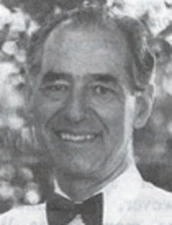Frank D. Stacey

The 1994 Louis Néel Medal is awarded to Frank D. Stacey in recognition of his outstanding and original work in rock magnetism and on the thermal structure of the Earth’s core and mantle.
Frank Stacey is truly a polymath with a catholicity of taste and a firm knowledge of condensed matter physics and thermodynamics. A physicist by training, his interests in geophysics were aroused by Louis Néels’s 1955 review of the theory of rock magnetism in the journal Advances in Physics. This led him to develop a theory of thermoremanence in multi-domained grains, complementing Néels single-domain theory valid for grains less than about 0.5um in diameter. Finding that neither theory was adequate for rocks with magnetic grains in the size range 0.5 – 20um, he introduced the concept of pseudo-single domain behaviour of small multi-domained grains: this has since been recognized as the carries of most stable remanence in igneous rocks.
He has also applied magnetic experiment and theory to a variety of problems of broad geological and geophysical importance, such as delineating rock fabric using magnetic anisotropy in which field his studies were the earliest, and in earthquake prediction using the property of piezomagnetism. In the field of earthquake prediction he showed that, in practice, the inference of a change in stress by the use of precursory changes in seismic velocity should be more difficult for deep sources. He argued that the link between stress and seismic velocity is the opening and closing of pores and fractures which must become less effective at high pressures and hence at greater depths. The results of these studies have been applied to exploration of rock ahead of an advancing mine face and to the capacitance micrometry observation of elastic hysteresis in rocks at seismic frequencies and strain amplitudes below 10, the range of linear inelastic damping.
Stacey has made original and widely respected contributions towards our understanding of the thermal evolution of the Earth’s core and mantle, though the application of thermodynamic principles to the dynamics of the Earth. He developed a new high pressure equation of state based on a lattice dynamical formulation for the Grüneisen parameter and explained the variation of Poisson’s ratio with pressure by a related study of bond lengths in a crystal subjected to shear with high compression. Frank Stacey’s fundamental physical ideas have been developed over the last two decades, within a broad view of geophysics, in the three successive editions of his widely used textbook, Physics of the Earth. The first edition, published in 1969, to paraphrase from W. Elasasser’s review in EOS, was the first geophysics textbook to deal with the whole solid Earth geophysics, from a physicists’ point of view, i.e. ‘How does the Earth work’? – these few words well summarize Frank Stacey’s scientific objectives throughout his career in geophysics.
Newsletter 51, 26, 1994
